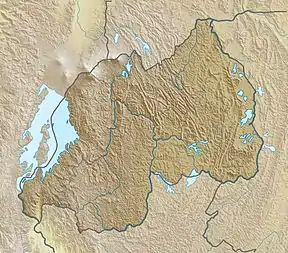Rusumo Hydroelectric Power Station
The Rusumo Hydroelectric Power Station, also known as the Rusumo Power Station, is a hydropower plant under construction,[1] with initial planned capacity installation of 80 megawatts (110,000 hp) when completed. The project will involve the construction of a dam, with run of river design. A more expensive 90 megawatts (120,000 hp) reservoir design was considered before being abandoned in favor of an 80 MW project with a smaller environmental impact and an estimated cost of US$300 million compared to US$400 million for the bigger project.[2] The World Bank announced on 6 August 2013 that it had approved loans totaling US$340 million towards the US$468.60 million needed for the project.[3] In November 2013, the African Development Bank approved a loan of US$113 million towards completion of the project.[4][5]
| Rusumo Hydroelectric Power Station | |
|---|---|
 Map of Rwanda showing the location of Rusumo Falls | |
| Country | Rwanda |
| Location | Rusumo Falls, Kirehe District |
| Coordinates | 02°22′57″S 30°47′03″E |
| Status | Under construction |
| Construction began | 2017 |
| Opening date | 2020 (est.) |
| Dam and spillways | |
| Impounds | Kagera River |
| Reservoir | |
| Normal elevation | 1,325 m (4,347 ft) |
| Commission date | 2020 (expected) |
| Type | Run-of-the-river |
| Turbines | 3 |
| Installed capacity | 80 MW (110,000 hp) |
Location
The power station is on the Kagera River, along Rwanda's border with Tanzania and approximately 2 kilometres (1.2 mi) downstream of the tripoint where the two countries share a common border with Burundi. The site is at Rusumo Falls, near the town of Rusumo, approximately 160 kilometres (99 mi), by road, southeast of Kigali, the capital and largest city of Rwanda.[6] Rusumo Falls is approximately 65 kilometres (40 mi), by road, south-east of the provincial headquarters at Kibungo.[7] The approximate coordinates of the power station are:2°22'56.0"S, 30°47'00.0"E (Latitude:-2.382222; Longitude:30.783333).[8]
Other considerations
The power generated will be shared equally among the countries of Burundi, Rwanda, and Tanzania.[4] The power will be evacuated from the generation plant via 220 kilovolt transmission lines to transmission stations in: Gitega, Burundi, a distance of 158 kilometres (98 mi); Kigali, Rwanda, a distance of 115 kilometres (71 mi); and, Nyakanazi, Tanzania, a distance of 98 kilometres (61 mi).[9]
Recent developments
In November 2016, two contracts that paved the way for construction of the power station were signed in Kigali, Rwanda. The first contract was between Rusumo Power Company Limited and a consortium of contractors that included a joint venture composed of CGCOC Group Limited and Jiangxi Water & Hydropower Construction Company Limited. This contract provides for the performance of civil works, including supply and installation of hydro-mechanical equipment.[10]
The second contract was signed between Rusumo Power Company Limited and a consortium of companies, including Rusumo Falls Andritz Hydro GmbH of Germany and Andritz Hydro PVT Limited of India, to carry out mechanical and electrical works for power generation.[10]
As of November 2016, the projected cost of the project is $340 million, to be financed by the World Bank. The three high voltage transmission lines that will evacuate the power generated are projected to cost $121 million, financed by the African Development Bank. Construction is planned to begin in January 2017.[10]
Construction
The ground-breaking ceremony was held at Ngara, in Tanzanian territory on 30 March 2017, attended by government officials from the three beneficiary countries; all members of the regional East African Community. The power station is owned by Rusumo Power Company Limited (RPCL), a special purpose vehicle company, owned by the three countries.[1]
Two contractors were selected for the project. A Joint Venture between CGCOC Group and Jiangxi Water & Hydropower Construction Company Limited is responsible for the civil works, while ANDRITZ Hydro from Germany and India are responsible for the electro-mechanical works.[1]
The Coordination Unit of the Nile Equatorial Lakes Subsidiary Action Program (NELSAP-CU), is implementing the project on behalf of the owners. Completion and commercial commissioning are expected in 2020.[1]
Construction work on this project was estimated at 35% as of February 2019, and 59% as of January 2020,[11] with completion still expected in 2020.[12]
References
- The Independent (30 March 2017). "Rwanda, Tanzania, Burundi start construction of Rusumo Dam". The Independent (Uganda). Kampala. Retrieved 21 May 2018.
- Musoni, Edwin (12 March 2012). "Rusumo Hydropower To Generate 80MW". New Times (Rwanda). Kigali. Retrieved 8 April 2016.
- World Bank (6 August 2013). "World Bank Approves Rusumo Falls Hydropower Plant". Washington, DC: World Bank. Retrieved 18 February 2015.
- Hydroword (27 November 2013). "Rwanda's 80 Megawatt Rusumo Falls Hydropower Project Receives $113 Million". Hydroworld.com. Retrieved 18 February 2015.
- AfDB (27 November 2013). "AfDB Board Commits US$113 Million to Regional Rusumo Falls Hydropower Project". African Development Bank (AfDB). Retrieved 18 February 2015.
- "Map Showing Kigali And Rusumo Falls With Route Marker". Globefeed.com. Retrieved 18 February 2015.
- "Road Distance Between Kibungo And Rusumo Falls With Route Marker". Globefeed.com. Retrieved 18 February 2015.
- Google. "Location of Rusumo Hydropower Station At Google Maps". Google Maps. Retrieved 18 February 2015.
- Mbesherubusa, Déogratias (2008). "Rusumo Falls: Water for Power Generation And Multipurpose Use, Burundi, Rwanda, Tanzania" (PDF). icafrica.org. Retrieved 18 February 2015.
- Mushimiyimana, Diane (11 November 2016). "Rusumo power project construction a step closer". New Times (Rwanda). Kigali. Retrieved 15 November 2016.
- Ilolo, Patricia (2020-01-13). "Rusumo hydroelectric power project in Tanzania now 59% complete". Construction Review Online. Retrieved 2020-04-08.
- Simon Peter Kaliisa (7 February 2019). "Construction of Rusumo power plant 35 per cent complete — officials". New Times (Rwanda). Kigali. Retrieved 7 February 2019.